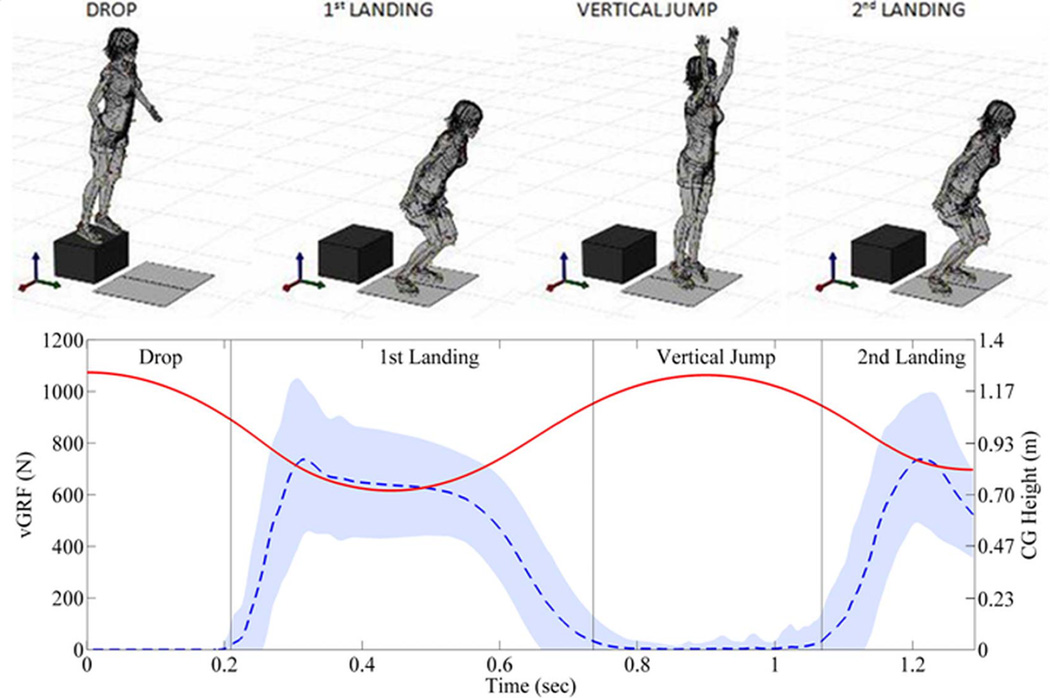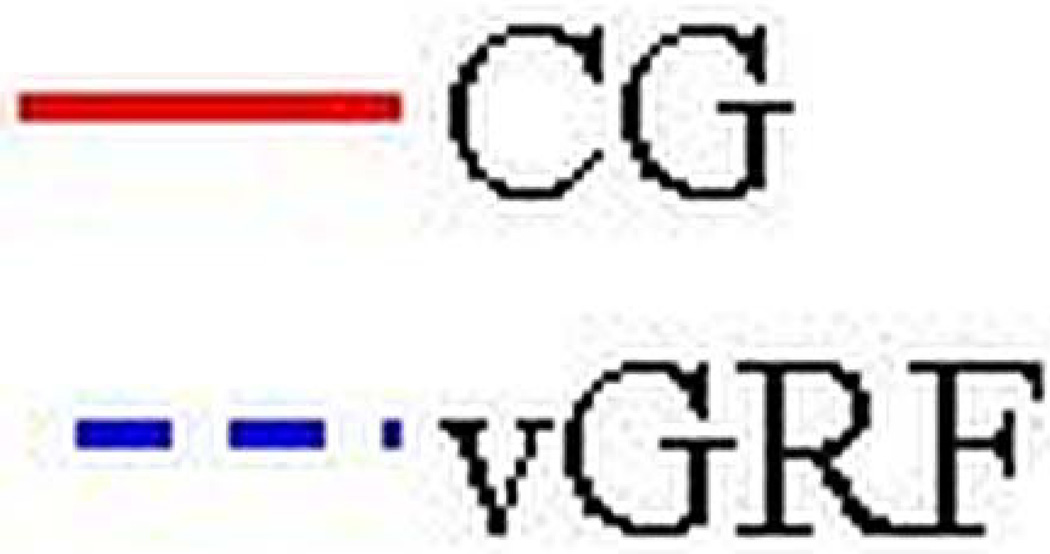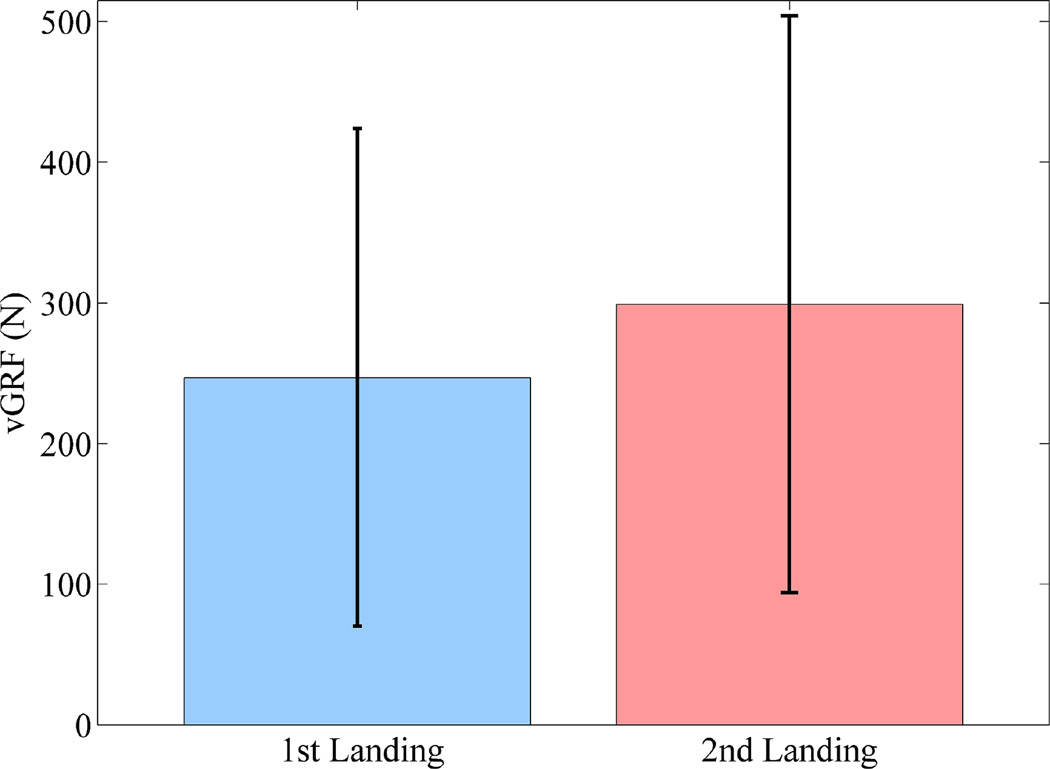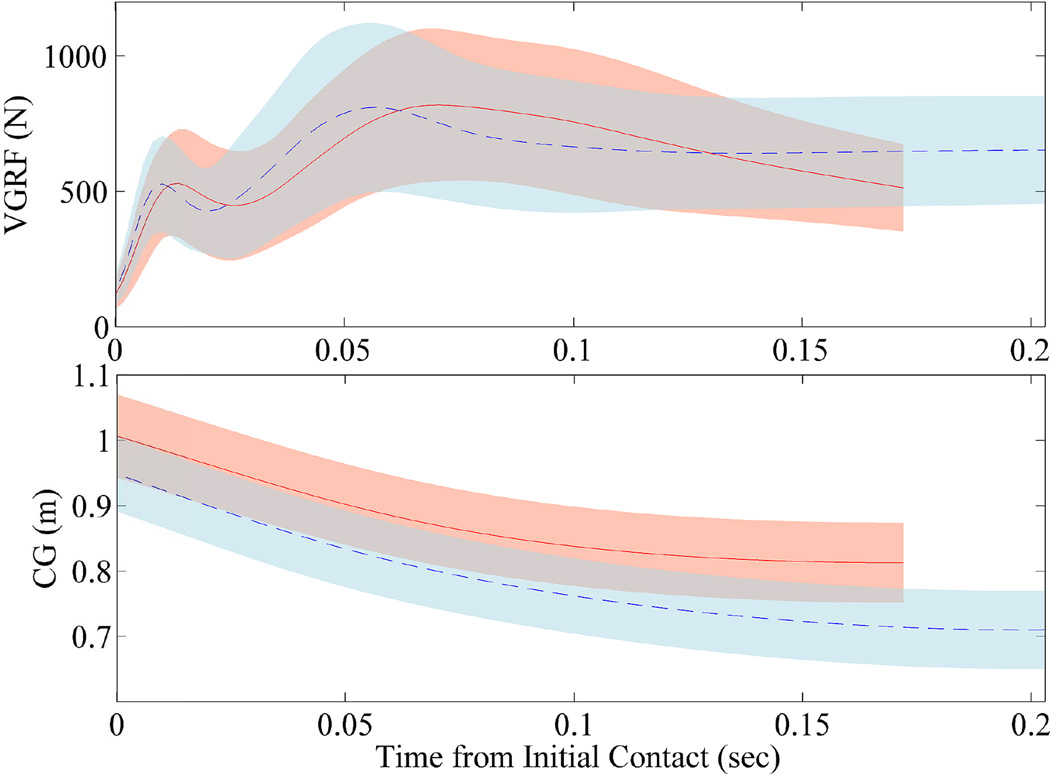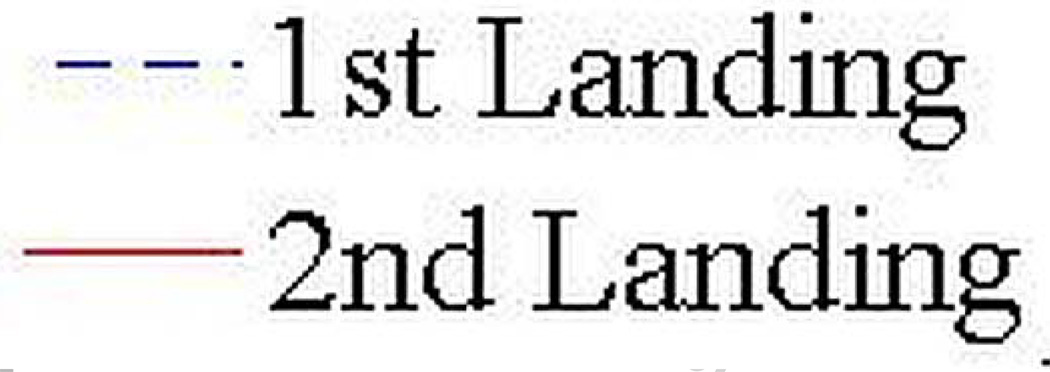Abstract
The drop vertical jump (DVJ) task is commonly used to assess biomechanical performance measures that are associated with ACL injury risk in athletes. Previous investigations have solely assessed the first landing phase. We examined the first and second landings of a DVJ for differences in the magnitude of vertical ground reaction force (vGRF) and position of center of mass (CoM). A cohort of 239 adolescent female basketball athletes completed a series of DVJ tasks from an initial box height of 31 cm. Dual force platforms and a three dimensional motion capture system recorded force and positional data for each trial. There was no difference in peak vGRF between landings (p = 0.445), but side-to-side differences increased from the first to second landing (p = 0.007). Participants demonstrated a lower minimum CoM during stance in the first landing than the second landing (p < 0.001). The results have important implications for the future assessment of ACL injury risk behaviors in adolescent female athletes. Greater side-to-side asymmetry in vGRF and higher CoM during impact indicate the second landing of a DVJ may exhibit greater perturbation and better represent in-game mechanics associated with ACL injury risk.
Keywords: Drop Jump, ACL, Reaction Force, Injury Prevention, Biomechanics
INTRODUCTION
Anterior cruciate ligament (ACL) injuries are catastrophic knee injuries that debilitate athletic careers, involve costly rehabilitation and lead to early onset arthritis (Lohmander et al., 2007; Lohmander et al., 2004). Investigation has identified soccer and basketball as the most frequent sources of ACL injury in adolescent athletes (Kelm et al., 2004). Female athletes incur ACL injuries at 4–6 times the rate of their male counterparts (Hewett et al., 2005; Hewett et al., 1999) such that one in every 60–80 female soccer or basketball players sustain an ACL injury (NHFS, 2002). Up to 70% of these injuries occur in non-contact situations and are associated with high-loading athletic tasks (Boden et al., 2000). Within female high school basketball, 60% of ACL ruptures are attributed to jumping or landing (Piasecki et al., 2003). Specifically, the jumping and landing task related to rebounding a ball is most frequently cited as the mechanism of ACL rupture by female basketball players (Powell and Barber-Foss, 2000).
The drop vertical jump (DVJ) task has been utilized to obtain measures related to ACL injury risk factors, including vertical ground reaction force (vGRF) (Hewett et al., 2005). Adolescent participants who drop from a box height of 30 cm generate peak vGRFs in excess of four times bodyweights (McNair and Prapavessis, 1999). VGRFs contribute to knee instability and are a primary loading mechanism of the knee joint and ACL (Hewett et al., 1996; Hewett et al., 2005; Yu and Garrett, 2007). Biomechanical factors such as increased drop height (Ford et al., 2011), decreased quadriceps to hamstrings activation ratio (Peng et al., 2011; Yeadon et al., 2010), poor neuromuscular control (Hewett et al., 2005), maturity (Lazaridis et al., 2010; Quatman et al., 2006), and increased joint stiffness (DeVita and Skelly, 1992; Myers et al., 2011) produce larger vGRFs and likely increased injury risk during landing. Greater vGRF upon landing likely enhances the probability of ACL injury as, prior to injury, participants who sustain ruptures exhibit 20% larger peak vGRFs during landing than participants who remain healthy (Hewett et al., 2005). The DVJ allows investigators to examine variation within these and other biomechanical risk factors such as joint kinetics and kinematics (Hewett et al., 2005) in order to prospectively screen athletes for potential ACL injury.
Despite the plethora of studies focused on vGRFs during the initial drop landing in a DVJ, little work has investigated the biomechanical behaviors of the second landing that follows a maximal vertical jump. The first landing of the DVJ is controlled, as athletes are provided instructions on how to initiate the drop, make contact, and position their feet. Conversely, explicit directions for the second landing are not documented in the literature. Studies have demonstrated that task instruction can immediately reduce peak vGRFs during landing (McNair et al., 2000; Prapavessis and McNair, 1999; Prapavessis et al., 2003). As vGRFs propagate through the closed kinetic chain and impart torsion moments across knee (Boden et al., 2000), increased vGRFs instigate larger moments that can create joint instability and place athletes, especially those with poor neuromuscular control, at risk of sustaining ACL injuries (Hewett et al., 2005). Therefore, relative to the first landing, the lack of instruction for the second landing in a DVJ may negatively impact neuromuscular controls and alter landing biomechanics related to increased injury risk. Coupled with a task change from drop jump to drop land, which is known to alter joint kinetics and muscle activation (Ambegaonkar et al., 2011), these factors warrant an investigation of how the second DVJ landing varies from the first.
The purpose of the current study was to determine how vGRFs and center of mass (CoM) kinematics from the second landing of a DVJ compare to those of the first landing. Our initial hypothesis was that participants would demonstrate altered vGRF and CoM behaviors between the first and second landings of a DVJ.
METHODS
Participants included in the current study were from a cohort in a prospective, longitudinal study. A population of 239 middle school (n = 162) and high school (n = 77) female basketball players (mass = 55.4 ± 13.2 kg, height = 1.60 ± 0.09 m, age = 13.6 ± 1.6 years) were tested immediately preceding their upcoming season. Basketball players were appropriate participants as they generate greater peak vGRF during jump landing than soccer players (Ford et al., 2011). Participants were not divided based on maturational status or excluded due to prior injury history as the scope of this testing was to depict results inclusive of an adolescent female basketball squad. Accordingly, 20% of participants had knee injury histories that ranged from anterior knee pain to joint fractures. Testing procedures were approved by the institution’s review board and informed written consent was obtained from the parent or legal guardian of each subject. Consent was also obtained from each subject prior to participation.
Subjects wore athletic shorts and tee shirts that were taped in a manner that exposed skin around the greater trochanter of the hip the lower lumbar and abdominal regions and were instrumented with 43 retroreflective markers for 3-D biomechanical analysis. Markers were placed on anatomical landmarks at the sternum, sacrum, left PSIS, C7, three points on the upper back, and bilaterally on the shoulder, elbow, wrist, ASIS, greater trochanter, midthigh, medial and lateral knee, tibial tubercle, midshank, distal shank, medial and lateral ankle, heel, dorsal surface of the midfoot, lateral foot, and toe. (Figure 1) The three upper back markers were attached to a thin backpack (Skeeter CamelBak, Petluma, CA) in a triangular pattern and the pack was securely tightened around the shoulders of each subject. The heel, midfoot, lateral foot, and toe markers were drilled into a standard pair of running shoes (Supernova, adidas, Herzogenaurach, Germany) that were provided to each subject based on foot size. Shoe model was standardized as variation in footwear can alter peak vGRF during landing (Oliver et al., 2011). A static trial, where participants were oriented into a standardized foot placement and instructed to rigidly stand in the anatomical position, was collected for each subject to define body segments, dimensions, and neutral standing alignment. After the static trial, markers at the medial and lateral ankles, medial knees, shoulder, sternum, and C7 were removed prior to the collection of dynamic motion. Motion was collected with a 10-camera motion analysis system (Eagle cameras, Motion Analysis Corporation, Santa Rosa, CA) and sampled at 240 Hz. vGRFs were collected by dual, in-ground, multi-axis force platforms (AMTI, BP600900 Watertown, MA) and sampled at 1200 Hz. Prior to motion capture each subject was measured for height with a stadiometer, body mass with a calibrated physician scale, shoe size to the nearest half size, and maximum vertical jump.
Figure 1.
Demonstration of marker set instrumentation on a subject.
Each subject performed three DVJ trials (Ford et al., 2003). The DVJ task initiated with a subject standing erect on top of a 31-cm box with their feet positioned 35 cm apart and arms held at their sides. The subject dropped down from the box onto dual force platforms and, upon landing, immediately transitioned into a maximum vertical jump. A basketball was suspended slightly above the maximum vertical jump height recorded for each subject to encourage maximum jump effort. Subjects were instructed to reach for and retrieve this target during the vertical jump. The DVJ was completed with a second landing on the force platforms. (Figure 2) During the initial drop, participants were directed to leave the box, drop straight down, and simultaneously land on both force platforms with separate feet. The box was positioned such that a straight drop allowed athletes to land with each foot on a separate force platform. If these requirements were not fulfilled, the trial was repeated. Instructions were not given for the second landing, nor were trials repeated. If participants failed to land with each foot completely contained in separate force platforms during the second landing, the trial was excluded from analysis as vGRF data would be incomplete. The landing phases of the DVJ were used for analysis due to the association of landing with ACL injuries.
Figure 2.
Virtual depiction of the four stages of a DVJ. Participants dropped from a box, landed on force platforms, executed a maximal vertical jump, and landed back on the platforms. The accompanying plot depicts the ensemble average progression of vGRF and CoM throughout the each stage of the DVJ task.
Landing phase data were processed in Visual3D (version 4.0, C-Motion, Inc, Germantown, MD) with custom Matlab (version 2010b, The Mathworks, Inc, Natick, MA) code. Each landing phase was identified with kinematic and kinetic data and defined as the point of initial contact with the force platforms to the lowest point of CoM during stance. Initial contact was defined as the first point when vGRF exceeded 10 N. Visual3D utilized relative positions of the retroreflective markers to define each body segment as a rigid body with length and volume. An internal biomechanical model assigned mass to each segment as a percentage of the subject’s bodyweight. Visual3D estimated subject CoM throughout the DVJ task based on the parameters and positions of each rigid body segments during every recorded frame of the motion capture. VGRF data were filtered through a fourth-order, low-pass, digital filter with a cutoff frequency of 100 Hz. Marker trajectories were filtered through a fourth-order, low-pass, digital filter with a cutoff frequency of 12 Hz (Ford et al., 2011). VGRF data were calculated during the first and second landing phases, while CoM positions were calculated throughout the full DVJ. Force values were reported as absolute values and normalized to bodyweight. For each subject, a mean of all successful trials was taken and used in data analysis.
The within subject variables of consecutive landing and contralateral sides were used in the statistical design. A 2-by-2 (side by landing type) repeated measures analysis of variance (ANOVA) was employed to assess differences in vGRF and CoM between first and second landing. Significance was determined at α ≤ 0.05. Absolute difference in peak vGRF per leg during landing phase was used to calculate side-to-side asymmetry.
RESULTS
Data from both the first and second landing phases are summarized in Table 1. When separated by first and second landing, participants demonstrated similar cumulative peak vGRF (p = 0.45), which were all above 1000 N per leg. The absolute difference in peak vGRF between the right and left legs within the first landing was 247 N and increased to 299 N within the second landing (p < 0.01; Figure 3). When separated by leg, neither the right leg nor the left leg individually demonstrated between landing differences in peak vGRF (p = 0.75 and 0.10; Figure 4).
Table 1.
Provides mean vGRF and CoM values per leg and landing. Force values are also presented in terms of bodyweight.
| 1st Landing |
2nd Landing |
|||
|---|---|---|---|---|
| Variable | Mean | Relative to Bodyweight |
Mean | Relative to Bodyweight |
| Peak GRF (N) | ||||
| Left leg | 1078 ± 324 | 2.00 | 1088 ± 313 | 2.05 |
| Right leg | 1163 ± 334 | 2.17 | 1110 ± 316 | 2.08 |
| Overall | 2241 ± 658 | 4.17 | 2198 ± 629 | 4.13 |
| CoM (m) | ||||
| Max in flight | 1.252 ± .062 | --- | 1.249 ± .079 | --- |
| Min in land | 0.710 ± .060* | --- | 0.813 ± .061* | --- |
| Land ROM | 0.238 ± .032* | --- | 0.194 ± .035* | --- |
indicates a significant difference was present between landings; ROM = range of motion
Figure 3.
Depiction of side-to-side differences in peak vGRF within each landing accompanied by standard deviation bars. The second landing displayed significantly greater differences.
Figure 4.
Ensemble average data that depicts differences between the first and second landing in vGRF and CoM relative to time from initial contact.
The minimum CoM height during stance phase increased from the first to second landing (p < 0.01; Table 1). There was no significant difference in the maximum CoM height during flight prior to both landings (p = 0.68; Figure 2). CoM total displacement following initial contact was smaller during the second landing as compared to the first landing (p < 0.001; Figure 4) No side-by-landing interaction was found for CoM measures (p = 0.46).
DISCUSSION
The purpose of the current study was to determine how vGRFs and CoM from the second landing of a DVJ compare to those of the first landing. It was found that though vGRFs are equivalent between the first and second landing, differences in CoM and asymmetry indicate that each landing enacts unique biomechanical and neuromuscular mechanisms.
Interestingly, peak vGRFs were comparable between landings, which lead us to accept the null hypothesis that vGRF would not change from the first to second landing. Greater fall heights prior to landing incrementally increase perturbations and, consequently, vGRFs on the lower extremity (Ford et al., 2011; Peng, 2011). The three millimeter difference in maximum CoM height prior to each landing was statistically equivalent, which caused the null hypothesis to be accepted, but justified the equivalent peak vGRFs recorded between landings. Also, peak vGRFs of 4.17 and 4.13 bodyweights observed in the first and second landing, respectively, compare favorably to previous literature where female athletes generated 4.20 bodyweights landing from a 30 cm box (McNair and Prapavessis, 1999). Therefore, in relation to peak vGRF, the second landing demonstrated no greater risk of instability or injury at the knee than the first landing.
The data supported a hypothesis of altered CoM between landings as participants exhibited smaller total displacement and a higher minimum CoM in the second landing. Participants who fall from greater drop heights demonstrate reduced knee and hip flexion and increased joint stiffness during landing (Ford et al., 2011). These behaviors correspond to a more rigid body that would be expected to exhibit a higher CoM than when landing from a smaller drop height that would generate less perturbation. The CoM height at initial contact was also higher for the second landing than the first, which signifies the lower extremity joints were more extended in flight prior to initial contact for the second landing than the first. Since greater stiffness is associated with larger landing perturbation (Myers et al., 2011), the increased minimum CoM during the second landing may increase perturbation of kinesthesia. Unlike previous drop landing research, change in perturbation between landings cannot be attributed to fall height differences as the maximum CoM height during flight that preceded each landing was statistically equivalent.
Since landing from a rebound is the task most commonly associated with ACL rupture in basketball (Powell and Barber-Foss, 2000), it is possible that the first drop landing task does not sufficiently simulate all the biomechanical mechanisms enacted when landing from a maximal vertical jump. The maximal exertion that predicates landing in a rebounding task and second landing may create a more unstable body posture in-flight that leads to increased stiffness and greater landing perturbation than experienced in the first landing. Additional perturbation during the second landing may also arise from a shift in the athlete’s focus. During the box drop and first landing, foot position and timing instructions were provided to the athletes, which directed their attention toward leg mechanics. During the maximal vertical jump and second landing, participants were given no mechanical instruction and concentrated on the hanging target provided. This second condition may provide a better representation of in-game scenarios where an object such as a basketball may divert attention away from mechanical control of the body and consequently increase the level of perturbation in a motion task.
The current findings demonstrated that absolute difference in side-to-side vGRFs increased from the first to second landing. The presence of side-to-side asymmetries during athletic tasks have been suggested as a precursor to non-contact ACL injuries (Pappas and Carpes, 2012; Paterno et al., 2007; Schot et al., 2006). Research has documented bilateral vGRF asymmetries of 12.8% when landing from a 50 cm box (Schot et al., 2006). Female athletes have shown larger peak vGRFs in the non-dominant limb during the first landing of a DVJ (Cowley et al., 2006). Asymmetry, as predicted by absolute difference in peak vGRF between legs, was observed in both landings of the current study and was approximately 0.1 times bodyweight greater in the second landing. Differences in bilateral asymmetry from first to second landing could result from variations in the tasks performed. In the first landing phase, each subject elicited a muscular response that counteracted the impact GRFs and then generated power for a vertical jump, while the second landing only necessitated the counteraction of impact GRFs. Though previous research has demonstrated that participants recovering from ACL reconstruction will generate the same peak vGRF as matched controls during a DVJ, asymmetry between sides has been shown to be larger in reconstruction populations than controls (Paterno et al., 2007). These findings corroborate the current work, as peak vGRF values are equivalent between first and second landings, but side-to-side asymmetry is greater in the second landing. Like ACL reconstruction participants versus controls, athletes in this study distribute comparable magnitudes of force across each leg, but enact different pathways of absorption on separate landings. Athletes with ACL reconstructions are known to have greater instability at the knee and high risk of experiencing subsequent ACL injury (Paterno et al., 2011). Therefore, the coupled larger asymmetry and equivalent vGRFs observed during the second landing of a DVJ indicate that participants may display mechanics more closely related to ACL injury risk than in the first landing.
There were potential limitations to this investigation. Several trials were excluded because participants did not successfully complete the second landing. Exclusionary criteria may have diminished observed differences, but they were designed around the collection of accurate force data. Overall, 205 participants (86%) completed a successful trials and provided sufficient power. Also, the desire to generalize results across an adolescent female basketball team created and inhomogeneous population. Pubertal development (Lazaridis et al., 2010; Quatman et al., 2006), participation in feedback or neuromuscular control programs (Hewett et al., 1996; Onate et al., 2001; Prapavessis and McNair, 1999), and the presence of knee injuries (Paterno et al., 2007; Paterno et al., 2011) impact biomechanical behavior; however, as these variables are not controlled for in the selection of a roster, they were not isolated in this investigation.
CONCLUSIONS
In adolescent female athletes, the first and second landing from a DVJ exhibit separate neuromuscular biomechanical pathways. Maximum vGRFs during impact and maximum CoM height in flight prior to landing were equivalent between landings and therefore indicated no increase in perturbation between landings. Nevertheless, side-to-side vGRF asymmetries and minimum CoM height were greater in the second landing, which indicated that athletes alter their mechanics, force distribution, and joint stiffness between landings. These factors are associated with increased ACL injury risk and the observed results indicate that athletes exhibit less neuromuscular control during the second landing. The second landing of a DVJ should be analyzed kinematically and kinetically to determine how forces are mechanically absorbed compared to the first landing.
ACKNOWLDGEMENTS
This work was supported by NIH grants R01-AR049735, R01-AR055563, R01-AR056259 and R03-057551. The authors thank the entire Sports Medicine Biodynamics Center at Cincinnati Children’s hospital for their support. The authors acknowledge Boone County, Kentucky, School District for participation in this study.
Footnotes
Publisher's Disclaimer: This is a PDF file of an unedited manuscript that has been accepted for publication. As a service to our customers we are providing this early version of the manuscript. The manuscript will undergo copyediting, typesetting, and review of the resulting proof before it is published in its final citable form. Please note that during the production process errors may be discovered which could affect the content, and all legal disclaimers that apply to the journal pertain.
CONFLICT OF INTEREST STATEMENT
There are no conflicts of interest.
REFERENCES
- Ambegaonkar JP, Shultz SJ, Perrin DH. A subsequentmovement alters lower extermity muscle activity and kinetics in drop jumps vs. drop landings. Journal of Strength and Conditioning. 2011;25(10):2781–2788. doi: 10.1519/JSC.0b013e31820f50b6. [DOI] [PubMed] [Google Scholar]
- Boden BP, Dean CS, Feagin JA, Jr, Garrett WE., Jr Mechanisms of anterior cruciate ligament injury. Orthopedics. 2000;23(6):573–578. doi: 10.3928/0147-7447-20000601-15. [DOI] [PubMed] [Google Scholar]
- Cowley HR, Ford KR, Myer GD, Kernozek TW, Hewett TE. Differences in neuromuscular strategies between landing and cutting tasks in female basketball and soccer athletes. Journal of Athletic Training. 2006;41(1):67–73. [PMC free article] [PubMed] [Google Scholar]
- DeVita P, Skelly WA. Effect of landing stiffness on joint kinetics and energetics in the lower extremity. Medicine and Science in Sports and Exercise. 1992;24(1):108–115. [PubMed] [Google Scholar]
- Ford KR, Myer GD, Hewett TE. Valgus knee motion during landing in high school female and male basketball players. Medicine and Science in Sports and Exercise. 2003;35(10):1745–1750. doi: 10.1249/01.MSS.0000089346.85744.D9. [DOI] [PubMed] [Google Scholar]
- Ford KR, Myer GD, Schmitt LC, Uhl TL, Hewett TE. Preferential quadriceps activation in female athletes with incremental increases in landing intensity. Journal of Applied Biomechanics. 2011;27(3):215–222. doi: 10.1123/jab.27.3.215. [DOI] [PMC free article] [PubMed] [Google Scholar]
- Hewett TE, Myer GD, Ford KR, Heidt RS, Jr, Colosimo AJ, McLean SG, van den Bogert AJ, Paterno MV, Succop P. Biomechanical Measures of Neuromuscular Control and Valgus Loading of the Knee Predict Anterior Cruciate Ligament Injury Risk in Female Athletes: A Prospective Study. American Journal of Sports Medicine. 2005;33(4):492–501. doi: 10.1177/0363546504269591. [DOI] [PubMed] [Google Scholar]
- Hewett TE, Lindenfeld TN, Riccobene JV, Noyes FR. The effect of neuromuscular training on the incidence of knee injury in female athletes. A prospective study. American Journal of Sports Medicine. 1999;27(6):699–706. doi: 10.1177/03635465990270060301. [DOI] [PubMed] [Google Scholar]
- Hewett TE, Stroup AL, Nacne TA, Noyes FR. Plyometric training in female athletes. Decreased impact forces and increased hamstring torques. American Journal of Sports Medicine. 1996;24(6):765–773. doi: 10.1177/036354659602400611. [DOI] [PubMed] [Google Scholar]
- Hughes G, Watkins J, Owen N. Differences between the sexes in knee kinetics during landing from volleyball block jumps. European Journal of Sport Science. 2010;10(1):1–11. [Google Scholar]
- Kelm J, Ahlhelm F, Anagnostakos K, Pitsch W, Schmitt E, Regitz T, Pape D. Gender-specific differences in school sports injuries. Sportverletz Sportschaden. 2004;18(4):179–184. doi: 10.1055/s-2004-813095. [DOI] [PubMed] [Google Scholar]
- Lazaridis S, Bassa E, Patikas D, Giakas G, Gollhofer A, Kotzamanidis C. Neuromuscular differences between prepubescents boys and adult men during drop jump. European Journal of Applied Physiology. 2010;110(1):67–74. doi: 10.1007/s00421-010-1452-4. [DOI] [PubMed] [Google Scholar]
- Lohmander LS, Englund PM, Dahl LL, Roos EM. The long-term consequence of anterior cruciate ligament and meniscus injuries: osteoarthritis. American Journal of Sports Medicine. 2007;35(10):1756–1769. doi: 10.1177/0363546507307396. [DOI] [PubMed] [Google Scholar]
- Lohmander LS, Ostenberg A, Englund M, Roos H. High prevalence of knee osteoarthritis, pain, and functional limitations in female soccer players twelve years after anterior cruciate ligament injury. Arthritis Rheumatology. 2004;50(10):3145–3152. doi: 10.1002/art.20589. [DOI] [PubMed] [Google Scholar]
- McNair PJ, Prapavessis H. Normative data of vertical ground reaction forces during landing from a jump. Journal of Science and Medicine in Sport. 1999;2(1):86–88. doi: 10.1016/s1440-2440(99)80187-x. [DOI] [PubMed] [Google Scholar]
- McNair PJ, Prapavessis H, Callender K. Decreasing landing forces: effect of instruction. Br J Sports Med. 2000;34(4):293–296. doi: 10.1136/bjsm.34.4.293. [DOI] [PMC free article] [PubMed] [Google Scholar]
- Myers CA, Torry MR, Peterson DS, Shelburne KB, Giphart JE, Krong JP, Woo SL, Steadman JR. Measurements of tibiofemoral kinematics during soft and stiff drop landings using biplane fluoroscopy. American Journal of Sports Medicine. 2011;39(8):1714–1722. doi: 10.1177/0363546511404922. [DOI] [PMC free article] [PubMed] [Google Scholar]
- NFHS, High School Participation Survey. Indianapolis: National Federation of State High School Associations; 2002. [Google Scholar]
- Oliver GD, Stone AJ, Booker JM, Plummer HA. A kinematic and kinetic analysis of drop landings in military boots. Journal of the Royal Army Medical Corps. 2011;157(3):218–221. doi: 10.1136/jramc-157-03-04. [DOI] [PubMed] [Google Scholar]
- Onate JA, Guskiewicz KM, Sullivan RJ. Augmented feedback reduces jump landing forces. J Orthop Sports Phys Ther. 2001;31(9):511–517. doi: 10.2519/jospt.2001.31.9.511. [DOI] [PubMed] [Google Scholar]
- Pappas E, Carpes FP. Lower extremity kinematic asymmetry in male and female athletes performing jump-landing tasks. Journal of Science and Medicine in Sport. 2012;15(1):87–92. doi: 10.1016/j.jsams.2011.07.008. [DOI] [PubMed] [Google Scholar]
- Paterno MV, Ford KR, Myer GD, Heyl R, Hewett TE. Limb asymmetries in landing and jumping 2 years following anterior cruciate ligament reconstruction. Clinical Journal of Sports Medicine. 2007;17(4):258–262. doi: 10.1097/JSM.0b013e31804c77ea. [DOI] [PubMed] [Google Scholar]
- Paterno MV, Schmitt LC, Ford KR, Rauh MJ, Myer GD, Hewett TE. Effects of sex on compensatory landing strategies upon return to sport after anterior cruciate ligament reconstruction. Journal of Orthopaedic and Sports Physical Therapy. 2011;41(8):553–559. doi: 10.2519/jospt.2011.3591. [DOI] [PubMed] [Google Scholar]
- Peng HT. Changes in biomechanical properties during drop jumps of incremental height. Journal of Strength and Conditioning Research. 2011;25(9):2510–2518. doi: 10.1519/JSC.0b013e318201bcb3. [DOI] [PubMed] [Google Scholar]
- Peng HT, Kernozek TW, Song CY. Quadricep and hamstring activation during drop jumps with changes in drop height. Physical Therapy in Sport. 2011;12(3):127–132. doi: 10.1016/j.ptsp.2010.10.001. [DOI] [PubMed] [Google Scholar]
- Piasecki DP, Spindler KP, Warren TA, Andrish JT, Parker RD. Intraarticular Injuries Associated with Anterior Cruciate Ligament Tear: Findings at Ligament Reconstruction in High School and Recreational Athletes. American Journal of Sports Medicine. 2003;31(4):601–605. doi: 10.1177/03635465030310042101. [DOI] [PubMed] [Google Scholar]
- Powell JW, Barber-Foss KD. Sex-related injury patterns among selected high school sports. American Journal of Sports Medicine. 2000;28(3):385–391. doi: 10.1177/03635465000280031801. [DOI] [PubMed] [Google Scholar]
- Prapavessis H, McNair PJ. Effects of instruction in jumping technique and experience jumping on ground reaction forces. Journal of Orthopaedic and Sports Physical Therapy. 1999;29(6):352–356. doi: 10.2519/jospt.1999.29.6.352. [DOI] [PubMed] [Google Scholar]
- Prapavessis H, McNair PJ, Anderson K, Hohepa M. Decreasing landing forces in children: the effect of instructions. Journal of Orthopaedic and Sports Physical Therapy. 2003;33(4):204–207. doi: 10.2519/jospt.2003.33.4.204. [DOI] [PubMed] [Google Scholar]
- Quatman CE, Ford KR, Myer GD, Hewett TE. Maturation Leads to Gender Differences in Landing Force and Vertical Jump Performance: A Longitudinal Study. American Journal of Sports Medicine. 2006;34(5):806–813. doi: 10.1177/0363546505281916. [DOI] [PubMed] [Google Scholar]
- Schot PK, Bates BT, Dufek JS. Bilateral performance symmetry during drop landing: A kinetic analysis. Medicine and Science in Sports and Exercise. 1994;26(9):1153–1159. [PubMed] [Google Scholar]
- Yeadon MR, King MA, Forrester SE, Caldwell GE, Pain MT. The need for muscle co-contraction prior to a landing. Journal of Biomechanics. 2010;43(2):364–369. doi: 10.1016/j.jbiomech.2009.06.058. [DOI] [PubMed] [Google Scholar]
- Yu B, Garrett WE. Mechanisms of non-contact ACL injuries. British Journal of Sports Medicine. 2007;41(Suppl 1):i47–i51. doi: 10.1136/bjsm.2007.037192. [DOI] [PMC free article] [PubMed] [Google Scholar]




